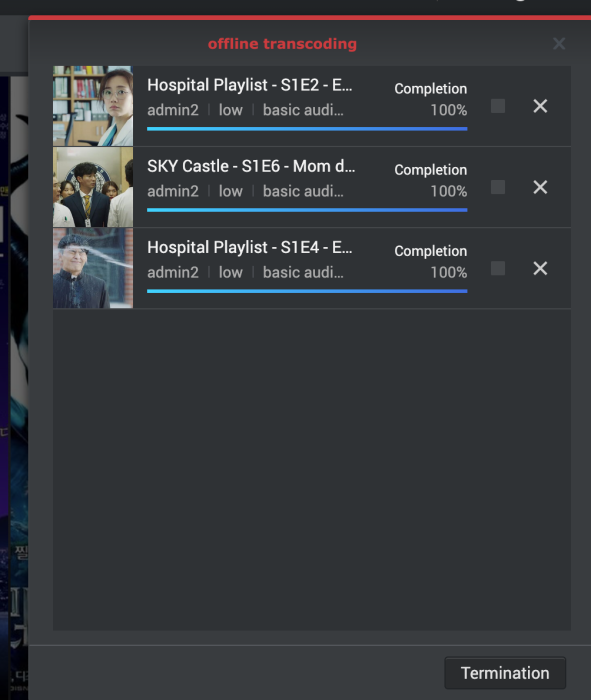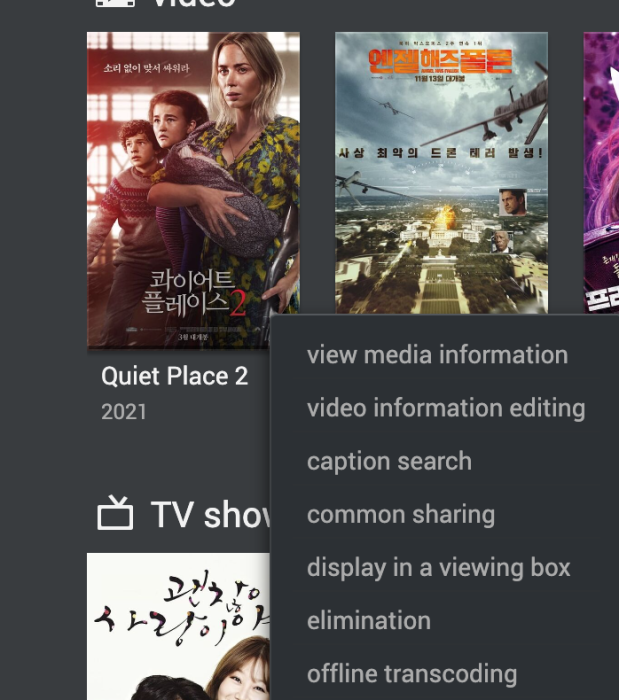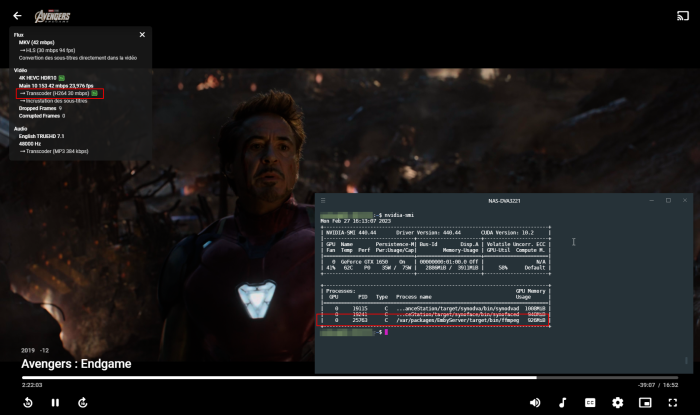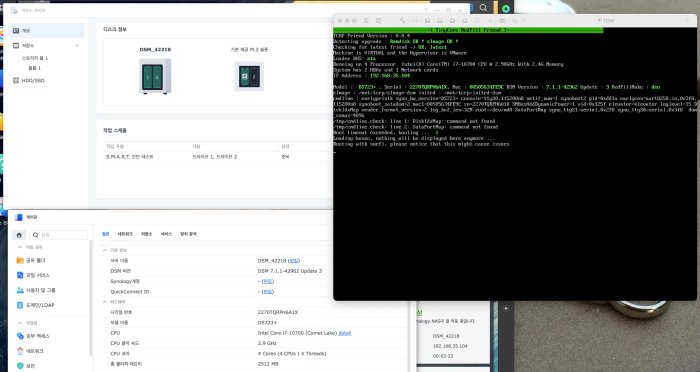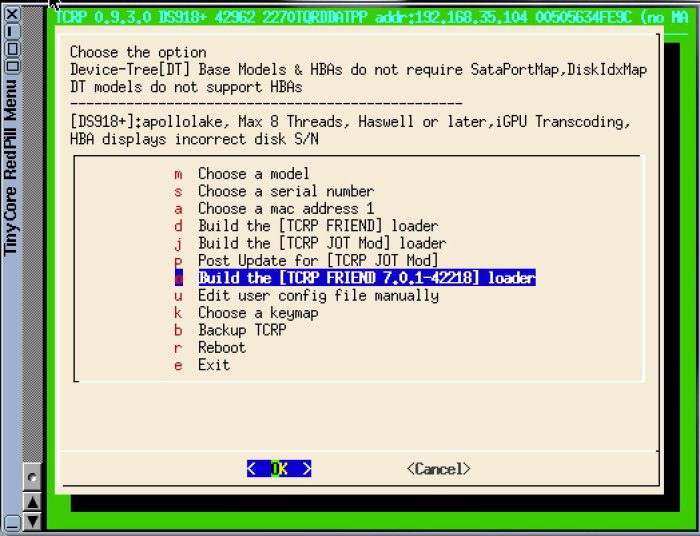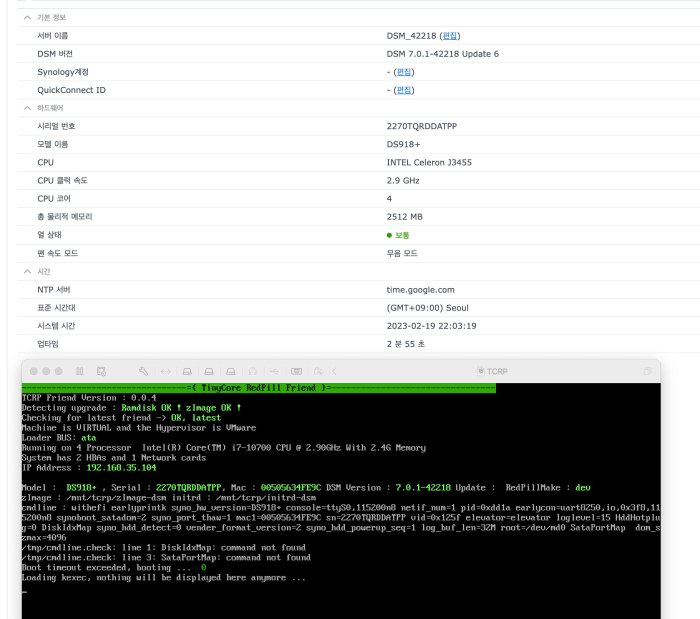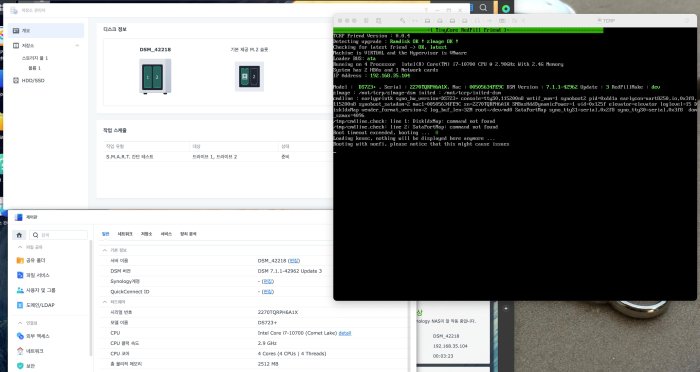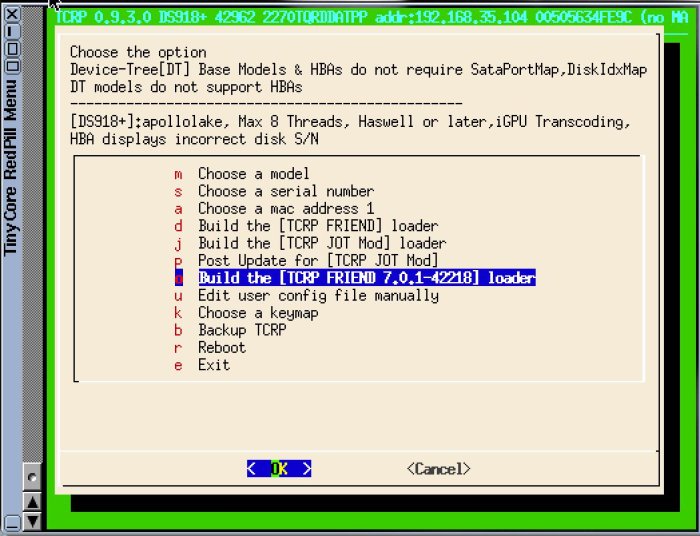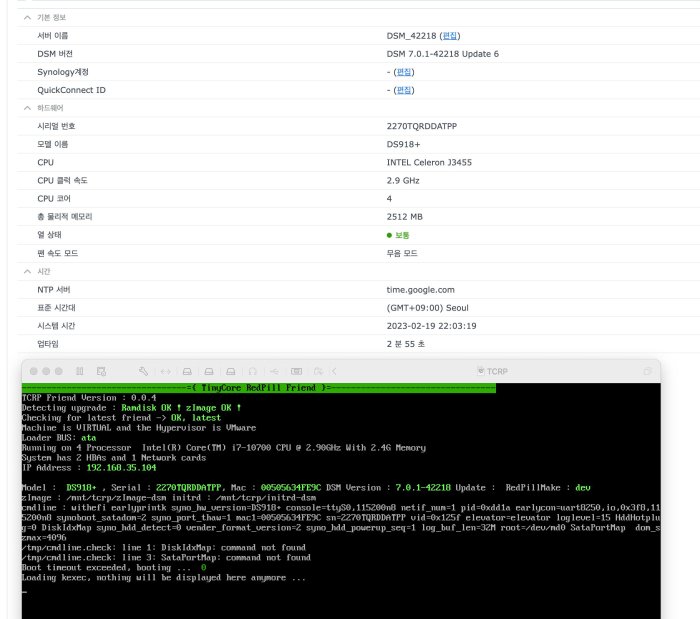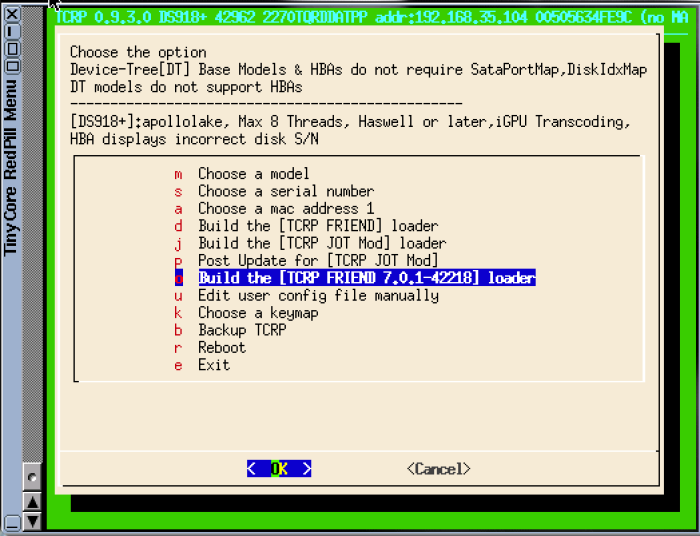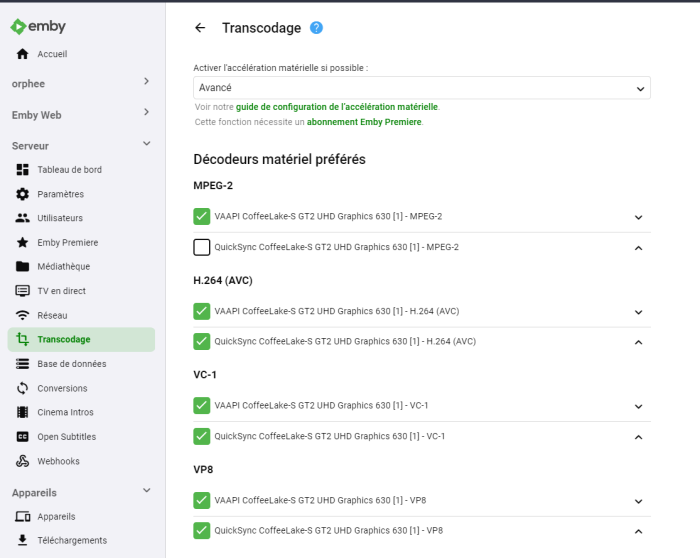Search the Community
Showing results for 'transcoding'.
-
I am using RP on a branded nas box with an lcd display. The folks using freenas/truenas have worked out a script to load on boot that allows you to read a multitude of info from this screen..cpu temp, ip, etc. Is there a way to make this script (which is for truenas/freenas) work on a RP 7.0.1 apollolake build? All this information is linked from this post. They even mention specific fan control, as the fan seems to be at max speed from boot on RP. This box has a Pentium N3710 with upgraded 16gb ram and 2 nic. DSM7 seems to work fine. Both lan ports work, drives are seen in order and successfully created a SHR btrfs pool. Shut down works.. all seems fine. (I have not tried transcoding for video as that is not my concern at this point, hopefully its task will simply be storage only) If anyone can assist me I would highly appreciate it. #!/bin/bash # # Post-init script for FreeNAS on Western Digital PR2100/PR4100 # wdhws v1.0 by TFL # # BSD 3 LICENSE # # thanks unix stackexchange question 231975 setup_tty() { tty=/dev/cuau3 exec 4<$tty 5>$tty } setup_i2c() { # load kernel modules required for the temperature sensor on the RAM modules kldload -n iicbus smbus smb ichsmb } send() { setup_tty # send a command to the PMC module and echo the answer echo -ne "$1\r" >&5 read ans <&4 if [ "$ans" = "ALERT" ]; then echo -ne ALERT >&2 exit 2 else # keep this for debugging failing commands if [ "$ans" = "ERR" ] || [ -z "$ans" ]; then echo "CMD $1 gives ERR at $2" >&2 send_empty ans=$(send "$1" $(($2 + 1))) #exit 1 fi fi # only echo the result for retries ($2 not empty) if [ ! -z $2 ]; then echo "CMD $1 gives '$ans' at $2" >&2 fi echo $ans send_empty # deconstruct tty file pointers, otherwise this script breaks on sleep exec 4<&- 5>&- } send_empty() { # send a empty command to clear the output echo -ne "\r" >&5 read ignore <&4 } get_ncpu() { # get the number of CPUs sysctl -n hw.ncpu } get_coretemp() { # get the CPU temperature and strip of the Celsius sysctl -n dev.cpu.$1.temperature | cut -d'.' -f1 } get_disktemp() { # get the disk $i temperature only if it is spinning smartctl -n standby -A /dev/ada$1 | grep Temperature_Celsius | awk '{print $NF}' } get_ramtemp() { # get the memory temperature from the I2C sensor smbmsg -s 0x98 -c 0x0$1 -i 1 -F %d } get_pmc() { # get a value from the PMC # e.g. TMP returns TMP=25 --> 25 send $1 | cut -d'=' -f2 } init() { setup_tty setup_i2c echo "get system status and firmware" send VER send CFG send STA show_welcome stop_powerled } show_welcome() { # set welcome message # maximum "xxx xxx xxx xxx " send "LN1= FreeNAS " send "LN2= go go go go go " } stop_powerled() { # stop blinking power LED send PLS=00 send LED=00 # set to 01 to enable it send BLK=00 } show_ip() { send "LN1=Interface re$1" ip=$(ifconfig re$1 | grep inet | awk '{printf $2}') send "LN2=$ip" } monitor() { lvl="COOL" # check RPM (fan may get stuck) and convert hex to dec fan=$(get_pmc FAN) rpm=$((0x$(get_pmc RPM))) echo "Got rpm $rpm" if [ "$rpm" != ERR ]; then if [ "$rpm" -lt 400 ]; then echo "WARNING: low RPM - $rpm - clean dust!" fi fi # check pmc tmp=$((0x$(get_pmc TMP))) if [ "$tmp" -gt 64 ]; then lvl="HOT" fi # check disks [adjust this for PR2100!!] for i in 0 1 2 3 ; do tmp=$(get_disktemp $i) echo "disk $i is $tmp" if [ ! -z $tmp ] && [ "$tmp" -gt 40 ]; then echo "Disk $i temperature is $tmp" lvl="HOT" fi done # check cpu for i in $(seq $(get_ncpu)); do tmp=$(get_coretemp $((i-1))) echo "cpu $i is $tmp" if [ "$tmp" -gt 50 ]; then echo "CPU $i temperature is $tmp" lvl="HOT" fi done # check ram for i in 0 1; do tmp=$(get_ramtemp $i) echo "ram temp is $tmp for $i" if [ "$tmp" -gt 40 ]; then echo "RAM $i temperature is $tmp" lvl="HOT" fi done echo "Temperature LVL is $lvl" if [ "$lvl" == HOT ] ; then if [ "$fan" != 40 ]; then send FAN=40 fi else if [ "$fan" != 20 ]; then send FAN=20 fi fi } check_btn_pressed() { btn=$(get_pmc ISR) #echo "Btn is .$btn." case $btn in 20*) echo "Button up pressed!" menu=$(( ($menu + 1) % 3 )) ;; 40*) echo "Button down pressed!" menu=$(( ($menu + 2) % 3 )) ;; *) return esac case "$menu" in 0) show_welcome ;; 1) show_ip 0 ;; 2) show_ip 1 ;; # if you add menu items here, update mod 3 uses above esac } # initial setup init while true; do # adjust fan speed every 30 seconds monitor # check for button presses for i in $(seq 30); do sleep 1 check_btn_pressed done done
-
I'm using 3E98 module and the commands works on mine but I still have synofaced and synodvad crashing : root@DVA1622:~# cat /sys/kernel/debug/dri/0/i915_frequency_info Video Turbo Mode: yes HW control enabled: yes SW control enabled: no PM IER=0x00000070 IMR=0xffffff8f ISR=0x00000000 IIR=0x00000000, MASK=0x00003fae pm_intrmsk_mbz: 0x80000000 GT_PERF_STATUS: 0x00000000 Render p-state ratio: 0 Render p-state VID: 0 Render p-state limit: 255 RPSTAT1: 0x24000000 RPMODECTL: 0x00000d92 RPINCLIMIT: 0x000018e7 RPDECLIMIT: 0x00003840 RPNSWREQ: 1200MHz CAGF: 1200MHz RP CUR UP EI: 4051 (5401us) RP CUR UP: 198 (264us) RP PREV UP: 0 (0us) Up threshold: 85% RP CUR DOWN EI: 8624 (11498us) RP CUR DOWN: 3495 (4660us) RP PREV DOWN: 0 (0us) Down threshold: 60% Lowest (RPN) frequency: 350MHz Nominal (RP1) frequency: 350MHz Max non-overclocked (RP0) frequency: 1200MHz Max overclocked frequency: 1200MHz Current freq: 1200 MHz Actual freq: 1200 MHz Idle freq: 350 MHz Min freq: 350 MHz Boost freq: 1200 MHz Max freq: 1200 MHz efficient (RPe) frequency: 350 MHz Current CD clock frequency: 337500 kHz Max CD clock frequency: 675000 kHz Max pixel clock frequency: 675000 kHz root@DVA1622:~# lspci -nnkkvq |grep -A14 UHD 0000:01:00.0 Display controller [0380]: Intel Corporation CoffeeLake-S GT2 [UHD Graphics 630] [8086:3e98] Subsystem: Super Micro Computer Inc Device [15d9:1a1d] Flags: bus master, fast devsel, latency 0, IRQ 39 Memory at c0000000 (64-bit, non-prefetchable) [size=16M] [virtual] Memory at 800000000 (64-bit, prefetchable) [size=256M] I/O ports at d000 [size=64] Expansion ROM at <ignored> [disabled] Capabilities: [40] Vendor Specific Information: Len=0c <?> Capabilities: [70] Express Endpoint, MSI 00 Capabilities: [ac] MSI: Enable+ Count=1/1 Maskable- 64bit- Capabilities: [d0] Power Management version 2 Capabilities: [100] Null Capabilities: [200] Address Translation Service (ATS) Capabilities: [300] Page Request Interface (PRI) Kernel driver in use: i915 And to be clear, in my case, HW transcoding works perfectly fine with Emby Premiere, so the module is working and the iGPU is correctly passed through the VM. But this is not the subject of this topic. Questions regarding specific DVA1622 should be/stay in dedicated topic.
-
As shown below, offline transcoding is the name specified by Video Station, and it is understood that it is not the real-time streaming transcoding supported by Plex, but encoding in advance at a low quality and linking to the existing video. PLEX has a similar feature.
-
I don't know what offline transcoding means.
-
Than you @Peter Suhfor response. re 1. I will have to downgrade to DS920+ DSM 7.0.1-42218 as I am on higher version right now and I assume your idea will not work on higher versions. re 3. as you said "Forget NVIDIA" then just using Intel Atom for HEVC/AAC will be not possible, so whole idea could be not possible to achieve but I will try anyway, just for curiosity re 12. you propose offline transcoding to it means I will need more space to keep original video and transcoded video? re @Orphée it is nice idea to use Jellyfin but is it also offline transcoding? It is funny to have nvidia processor near to intel processor on the same board and totally not use it where nvidia offers some extra power as coprocessor e.g. using CUDA.
-
@Peter Suh HW transcoding works with Nvidia card and DVA3221 loader as long as you have a compatible Nvidia card (and >= Haswell CPU). I do it myself perfectly fine : But I agree with you about plex pass or emby premiere (in my case) Edit : You can do it also without any subscription with Jellyfin... I did it as a proof or concept on DVA3221 thread in the beginning.
-
The ultimate goal of Xoxer is video HW transcoding. The only platforms capable of video HW transcoding are Apollo Lake and Gemini Lake. A DS918+ or DS920+ looks good. HW transcoding through plex requires the purchase of plex pass. HW transcoding of video station is possible without genuine SN within DSM 7.0.1-42218. However, I don't have a 2nd generation Atom CPU, so I can't confirm if HW transcoding is really guaranteed. Choose between ARPL / TCRP (currently only M SHELL has no problem) After finishing the build of DS918+ / DS920+ DSM 7.0.1-42218 Loader It would be easy to do HW transcoding with only the integrated graphics. Forget NVIDIA. Try adjusting the video station's settings as instructed below. 1. Install DSM 7.0.1-42218 2. Install Advanced Media Extensions from Package Center 3. Check HEVC/AAC in Advanced Media Extensions 4. Video station installation 5. Manual installation of synocommunity ffmpeg. https://synocommunity.com/packages 6. Transcoding patch (all items) curl -L "https://raw.githubusercontent.com/Yanom1212/synocodectool-patch/master/patch.sh" -O;sh patch.sh -p 7. cat /usr/syno/etc/codec/activation.conf Confirm that the transcoding patch is enabled by checking the content 8.ll /dev/dri/renderD128 Check if the above path exists 9. video station patch 1 bash -c "$(curl "https://raw.githubusercontent.com/AlexPresso/VideoStation-FFMPEG-Patcher/master/patcher.sh")" 10. video station patch 2 ,Install only all bash -c "$(curl "https://raw.githubusercontent.com/darknebular/Wrapper_VideoStation/main/installer.sh")" 11. Enable hardware transcoding check in Video Station Advanced Settings 12. Upload a movie or video from ds video or plex to check offline transcoding
-
Which one will be better for hw transcoding on Proxmox running with xeon e5v3 (2,4 - 3,2 ghz turbo)? For now I was testing DS3617 platform that can support 16 cpu threads. Another thing is that I need around 8 or even more sata ports. Will it be better if I use DS918 with newer kernel? From the table I read it support ssd cache but does it support at least 8 hdds and does 8 cpu threads will be enough for transcoding?
-

TinyCore RedPill Loader Build Support Tool ( M-Shell )
Peter Suh replied to Peter Suh's topic in Software Modding
[NOTICE] Distribute the new model DS723+ and the 7.0.1-42218 version of the transcoding model. Adds one more model of r1000 platform like DS923+ to M SHELL for TCRP. The DS723+ has two bays. Like DS923+, it seems to show high compatibility with Ryzen CPU XPE. The DS923+ and DS723+ models can be used by converting M.2 NVMe to non-cache SSD data disks without any special tricks. https://kb.synology.com/en-us/DSM/tutorial/Which_models_support_M_2_SSD_storage_pool Next, in M SHELL for those who want to use it without genuine SN in transcoding Expanded the menu for the 7.0.1-42218 version build for the three models DS918+, DS920+, DS1019+. If it is not the above 3 models, the menu itself is not visible. If you are using M SHELL in the past, it will be automatically updated at the point of entry into TCRP Linux. If the update is not successful, please update and re-execute directly with the command below. curl -L "https://github.com/PeterSuh-Q3/tinycore-redpill/raw/main/my.sh.gz" -O tar -zxvf my.sh.gz ./rploader.sh backup ./menu.sh -
[NOTICE] Distribute the new model DS723+ and the 7.0.1-42218 version of the transcoding model. Adds one more model of r1000 platform like DS923+ to M SHELL for TCRP. The DS723+ has two bays. Like DS923+, it seems to show high compatibility with Ryzen CPU XPE. The DS923+ and DS723+ models can be used by converting M.2 NVMe to non-cache SSD data disks without any special tricks. https://kb.synology.com/en-us/DSM/tutorial/Which_models_support_M_2_SSD_storage_pool Next, in M SHELL for those who want to use it without genuine SN in transcoding Expanded the menu for the 7.0.1-42218 version build for the three models DS918+, DS920+, DS1019+. If it is not the above 3 models, the menu itself is not visible. If you are using M SHELL in the past, it will be automatically updated at the point of entry into TCRP Linux. If the update is not successful, please update and re-execute directly with the command below. curl -L "https://github.com/PeterSuh-Q3/tinycore-redpill/raw/main/my.sh.gz" -O tar -zxvf my.sh.gz ./rploader.sh backup ./menu.sh
-

TinyCore RedPill loader (TCRP) - Development release 0.9
Peter Suh replied to pocopico's topic in Developer Discussion Room
@pocopico It looks like you've been very busy lately. I solved the issue I was asking about a few days ago on my own. As of 02/02/2023, I noticed that the DSM in 7.0.1-42218 has been modified and the bsp files need to be rebuilt accordingly. Below is the new menu for DSM 7.0.1-42218 of M SHELL for TCRP and supports only DS918+, DS920+, DS1019+ with transcoding. If you want your TCRP to work with 7.0.1-42218 you will need to do the same as me. -
Good morning all, After my research and tests on my current machine via VmWare for the virtualization of a successful DS918 with the latest update, and plex on windows 10. My project aims to achieve a high-performance and scalable NAS over time, which can ensure: - Minimum 2 4K HDR transcoding simultaneously on the local network. - Network storage space for the whole family. - virtualization tool as part of my system administrator training. Total of the order 630 € Hardware: CPU: Intel core I3 9100F ==> I3 8100 CM: Asus prime B365M-K RAM: DDR4 G. Skill Aegis, 8 GB (2 x 4 GB), 2400 MHz, CAS 15 HDD: To begin with RAID 5 of 3 Seagate IronWolf Pro disks, 2 TB. Case: I fell for this one: Fractal Design Node 804, Black I already have a LEPA 450watt power supply. The ratio: price / performance / energy is consistent compared to what synology offers because a DS918 is 600 € without hard drives. I would like to know which Xpenology will be the best performing and the most compatible for my project? - DS918 + - DS3617XS Edit : Modification of the title of the topic following the discussion, passage from I9100F to I3 8100
-

TinyCore RedPill loader (TCRP) - Development release 0.9
Peter Suh replied to pocopico's topic in Developer Discussion Room
@pocopico There are users who want to use transcoding on DS918+,DS920+,DS1019+, but want to use 7.0.1-42218 as FRIEND to avoid the genuine SN required by AME in DSM 7.1.0 or later. Currently 7.0.1-42218 has had another DSM file update The config checksums are mismatched. I did some tweaking to get the checksum right, but it reboots with KP as if your tcrpfriend module doesn't support 7.0.1-42218. Can you modify the above 3 models to be usable with 7.0.1-42218 with friend? -

HW transcoding in Plex not working (TCRP DSM 7.1)
Rayqusa replied to miicker's topic in Third Party Packages
how to do that? edit: I mean force install codecs on 7.1.1 I have seen transcoding on 6.x.x but never known 7x.x -
As I know it is not possible to transcode videos in Xpenology as VM on ESXI. For now I have Xpenology 918 as VM to manage shr pool, downloads, audio station, etc, but I am thinking how to transcode videos by DLNA. Its good that I can play videos by build in dsm media center but I have a lot of videos that my tvs can not play. I can not get Plex spk and Jellifyn in Docker to work. What are Your suggestions to have a multimedia server that can transcode not supported videos from Xpenology and be able to play videos with srt files? Maybe some unix distro like Ubuntu VM + Docker + Jellyfin?
-
I can suggest few options: Buying an off-the-shelf NAS (secondhand is acceptable IMO). Off-the-shelf NAS uses low-energy boards for reasons. I'm using QNAP TS-469 Pro, and recorded about 45-55 W of normal usage. Buy Intel J series board. They use 10W TDP, have igp (for transcoding), affordable, and use less space (typically SFF). The most recent one is J6412, but J4125 is still pretty decent (and also native HW of DS918+). But you'll need a sata card because they typically have only 2 sata ports. 25W TDP is your next option if you don't want Intel J series.
-
Ok so it seems only epyc7002 has the following line in i915_pciids.h : INTEL_VGA_DEVICE(0x3E98, info), /* SRV GT2 */ \ Edit : Ok I just had to add the missing line before building the i915.ko driver and it worked, I was able to unload/reload i915 module : 0000:01:00.0 Display controller: Intel Corporation CoffeeLake-S GT2 [UHD Graphics 630] Subsystem: Super Micro Computer Inc Device 1a1d Flags: bus master, fast devsel, latency 0, IRQ 33 Memory at fc000000 (64-bit, non-prefetchable) [size=16M] Memory at e0000000 (64-bit, prefetchable) [size=256M] I/O ports at 5000 [size=64] Capabilities: [40] Vendor Specific Information: Len=0c <?> Capabilities: [70] Express Endpoint, MSI 00 Capabilities: [ac] MSI: Enable+ Count=1/1 Maskable- 64bit- Capabilities: [d0] Power Management version 2 Capabilities: [100] Null Capabilities: [200] Address Translation Service (ATS) Capabilities: [300] Page Request Interface (PRI) Kernel driver in use: i915 Emby trancode log : >>>>>> User policy for orphee Enable Playback Remuxing: True Enable Video Playback Transcoding: True Enable Audio Playback Transcoding: True >>>>>> Hardware Decoders for hevc [X] VAAPI CoffeeLake-S GT2 UHD Graphics 630 [1] - H.265 (HEVC) [X] QuickSync CoffeeLake-S GT2 UHD Graphics 630 [1] - H.265 (HEVC) >>>>>> Hardware Encoders for h264 [X] VAAPI CoffeeLake-S GT2 UHD Graphics 630 [1] - H.264 (AVC) [X] QuickSync CoffeeLake-S GT2 UHD Graphics 630 [1] - H.264 (AVC) >>>>>> Selected Codecs Decoder VAAPI CoffeeLake-S GT2 UHD Graphics 630 [1] - H.265 (HEVC) Adapter #1: 'CoffeeLake-S GT2 UHD Graphics 630 [1]' Id:16024 (Driver: Intel iHD driver for Intel(R) Gen Graphics - 21.2.2 (27b773b2), Vendor: Intel Corporation) Max Bitrate: 117 Mbit/s - Frame Sizes: max 8192x8192 Color Formats: NV12, P010 - Bit Depths: 8, 10 Profiles: Main Profile (Level 6.1), Main 10 Profile (Level 6.1) Encoder VAAPI CoffeeLake-S GT2 UHD Graphics 630 [1] - H.264 (AVC) Adapter #1: 'CoffeeLake-S GT2 UHD Graphics 630 [1]' Id:16024 (Driver: Intel iHD driver for Intel(R) Gen Graphics - 21.2.2 (27b773b2), Vendor: Intel Corporation) Max Bitrate: 234 Mbit/s - Frame Sizes: 32x32...4096x4096 Color Formats: NV12 - Bit Depths: 8 Profiles: Main Profile (Level 6), High Profile (Level 6), Constrained Baseline Profile (Level 6) >>>>>> FindVideoEncoder - MediaType: h264, UseHardwareCodecs: True, HWA-Mode: Automatic Info Checking: 'VAAPI CoffeeLake-S GT2 UHD Graphics 630 [1] - H.264 (AVC)' Info Check successful - selecting 'VAAPI CoffeeLake-S GT2 UHD Graphics 630 [1] - H.264 (AVC)' >>>>>> FindVideoDecoder - MediaType: hevc, UseHardwareCodecs: True, HWA-Mode: Automatic Info Checking: 'VAAPI CoffeeLake-S GT2 UHD Graphics 630 [1] - H.265 (HEVC)' Info Check successful - selecting 'VAAPI CoffeeLake-S GT2 UHD Graphics 630 [1] - H.265 (HEVC)' Info Tone Mapping would be desired, but hardware tone mapping is disabled >>>>>> Processing Plan Name CanDoInHW WillDoInHW Reason VAAPI CoffeeLake-S GT2 UHD Graphics 6... >> True True Hardware Codec VideoInput >> True True Same adapter (/dev/dri/renderD128), same hardware co... ToneMapping (when possible) >> True True VideoOutput >> True True Hardware encoder VAAPI CoffeeLake-S GT2 UHD Graphics 6... >> True True Hardware Codec >>>>>> Video Processing Steps for [0:0]: H.265 (HEVC) Step HW-Context Format SW-Format Size Next HEVC >> VAAPI vaapi_vld yuv420p10 3836x2074 >> scale_vaapi scale_vaapi >> VAAPI vaapi_vld nv12 3836x2074 >> @pocopico @fbelavenuto Could you please take this i915.ko for geminilake and add it in your repo ? i915.ko
-
Hi, I just want to thank everyone with this piece of software. I used a lot of time on an old Asrock Q2900 ITX, now I bought a new(ish) MSI H81i for using hw acceleration and having a better system. My CPU is a 4460T (35w TDP, Haswell refresh) and it has got an integrated HD 4600 GPU. Network works fine since it's Realtek r8111 based. I have a couple of problems, the main one is that it reboot when I try to see a video in Video Station on my browser with HW acceleration enabled. It starts and encoding works, but as soon as i stop it or move the slider my system reboot. My conditions: - real mac / serial combo, took from a dead unit, I even have synology.me working - jun's loader 1.04b, for ds918+ - /dev/dri is populated cat /usr/syno/etc/codec/activation.conf {"success":true,"activated_codec":["h264_dec","h264_enc","mpeg4part2_dec","aac_dec","aac_enc","hevc_dec","vc1_dec","vc1_enc","ac3_dec","mpeg4part2_enc"],"token":"d686df0830fa070505494ed7d9787fa2"} Other problems: - my system will not boot without HDMI connected How can I solve it? I tried some
- 9 replies
-
- transcoding
- h264
-
(and 3 more)
Tagged with:
-
I had previously tried that synocodec tool with no luck for whatever reason. I think the issues related to HW transcoding are more from Synology rather than Plex itself.
-
I'm still at a loss to understand why Plex software itself, if it can be install on a Synology/QNAP/Unraid etc. or with the aid of some add-on software, can't directly take advantage of the Intel QuickSync instruction set. Having a platform functionality deficient in this way, is astonishing and ludicrous, it should be platform agnostic. I'm sure there are folks that have more content, than a 918/920 can cost effectively hold, so something like a 3622 with HW transcoding would make total sense. Having said that, this would imply such a possibility given that the 3615/3617 aren't intended to HW transcode, but yet, this seems to makes it possible. Soooo, maybe it could work on 3622. 🤠 https://github.com/wirgen/synocodectool-patch
-
Hello guys, The amount of documentation here had increased a lot, and I wanted to say thanks to @flyride and everyone else who made it possible. Now is amazingly better than before. If some of the information I am about to ask is already in place -and my understanding is wrong-, apologies in advance, I will correct/update the post. I still see several things that could be improved information/documentation wise: 0) As per today is there any limitation if you compare RedPill Loader vs Jun's loader? Just to know if all the Jun's functionalities are achieved/surpassed with this new Loader or still there are any things that are better in Jun's loader that couldn't be achieved with the RedPill Loader (and not talking about being monolithic). 1) RedPill Loader and methods of installation information. Now a lot of people is using RedPill Loader, using TinyCore RedPill Loader (TCRL) or Automated RedPill Loader (ARPL). It looks they are treated like if both were different loaders (in fact, there is just one guide made by flyride for TCRL, but non for ARPL), but (I guess) they are using the same exact loader (or not?). I asked that because now to me, is hard to separate the concepts and the loader. I even thought at first that ARPL was another level of abstraction over the TCRL, but it looks like is not. Several questions about it: - Is the RedPill Loader (not TCRL or ARPL), being developed separately (and still active and changed often?, as the ThorGroup left the project?), or is being developed in conjunction of the TCRL or ARPL? - Which leads to, would love to know the boundaries of each one. What exactly does RedPill Loader, TCRL and ARPL. - If we install one of the TCRL, or ARPL, then are we constrained afterwards in any way, I mean, we can swap from TCRL to ARPL and viceversa at any point. - @flyride, can you update the RedPill Loader guide for not just using TCRL but choosing ARPL be done. If you chose between them, why one over the other, if it matters. - And this could be a question for both developers of TCRL (@pocopico) and ARPL (@fbelavenuto). Why not unifying both TCRL and ARPL? As it looks like would benefit both approaches and probably easy to maintain and not waste individual efforts. 2) Information about how to update to a new version of DSM, and updating the loader too. Information about updating to a new DSM version. What are the steps needed for that (probably I guess based on the method we used to install it). For what I understand if we update to a new version the RedPill Loader will not work anymore and has to be updated. - What could be the procedures for updating, if there are any automated process for it to make it easier for the users perspective? - Is possible to make it with DSM update directly or has to be manual? 3) RedPill Loader future questions * Regarding changing limitations to some platforms. Like for these examples: - Would be possible to change for example the numbers of max cores in a DS918+ platform? - Or in DS3622xs+, should be possible to add transcoding on it? Is there any way to compile and make a compatible kernel for the DSM to achieve that? * Any way to make the Loader update proof? * Any other future plans which could be discussed? Thanks guys, and sorry for the big chunk of text. E.
-
Thank you Peter for the info, most appreciated. I was actually just wanting to upgrade it from the 6.2.3-25426 U3 to the DSM 7.x with actually the intent to EOL the box. I have a newer, better system, the I am hoping to go forward with. In actually, I do not need to numerous drive support of the DS36xx models, I would actually like to convert to the DS920+ in my future build, assumed it would be easier going from 7.x to 7.x and changing models too, which I assume is possible. I'm still debating BTRFS vs EXT4, but figure on the new platform, might as well go for the new FS as well, since I am not going to be running SS. Do you think I should upgrade from DS3615xs (6.2.3) to DS3622xs+ (7.0.1) then to DS920+? I'm largely using it for Plex (wanting the transcoding) and then general storage, cloud/remote access possible later. Any thoughts are always appreciated!
-
Переход на 7.Х.Х с помощью Automated Redpill loader
The Chief replied to Olegin's topic in Програмное обеспечение
Я так переходил на Asrock J3355B-ITX, благо настроек в нём всего ничего, только Synthing, на него бэкапы льются. В лоадере ARPL это называется Force reinstall DSM, данные на созданном пуле/томе сохраняются, а системный раздел сначала форматируется. А вот на основном ASUS я успешно мигрировал с 6.2.3 в два этапа, 6.2.3→7.0.1→7.1.1, как сама Synology предлагает для оригинальных DS918+. Переехало всё идеально, кроме BubbleUPnP (для него автор не собирает версю под DSM7), но он прекрасно ставится в варианте 'Any Java plaform' ручками в рута (c OpenJDK11 из репо SynoCommunity) и прекрасно же подхватывает ffmpeg с HW transcoding (из того же репо).

